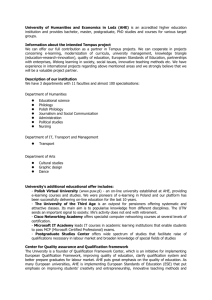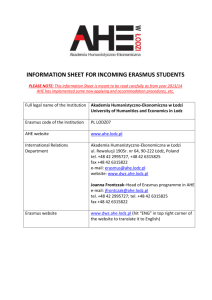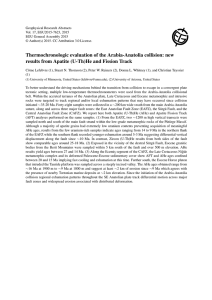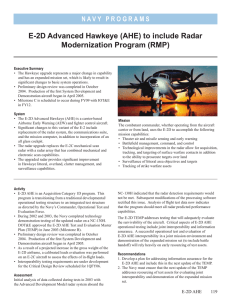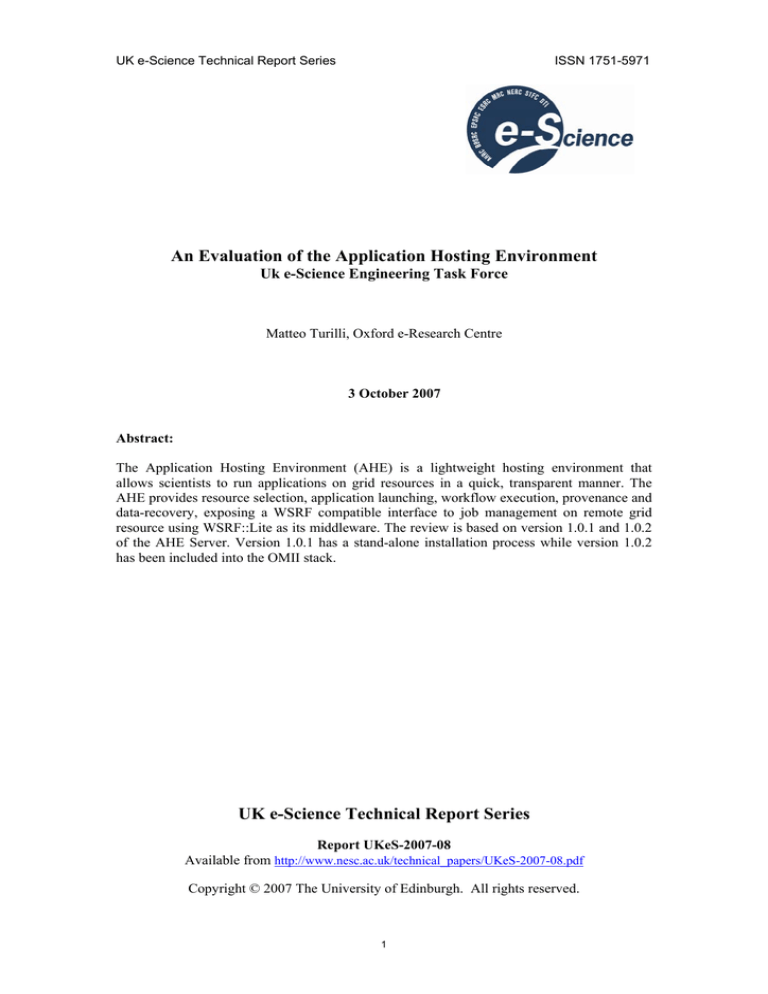
UK e-Science Technical Report Series
ISSN 1751-5971
An Evaluation of the Application Hosting Environment
Uk e-Science Engineering Task Force
Matteo Turilli, Oxford e-Research Centre
3 October 2007
Abstract:
The Application Hosting Environment (AHE) is a lightweight hosting environment that
allows scientists to run applications on grid resources in a quick, transparent manner. The
AHE provides resource selection, application launching, workflow execution, provenance and
data-recovery, exposing a WSRF compatible interface to job management on remote grid
resource using WSRF::Lite as its middleware. The review is based on version 1.0.1 and 1.0.2
of the AHE Server. Version 1.0.1 has a stand-alone installation process while version 1.0.2
has been included into the OMII stack.
UK e-Science Technical Report Series
Report UKeS-2007-08
Available from http://www.nesc.ac.uk/technical_papers/UKeS-2007-08.pdf
Copyright © 2007 The University of Edinburgh. All rights reserved.
1
ETF Grid Middleware Evaluation – AHE Server/Client
Installation
General Information
“The Application Hosting Environment (AHE) is a lightweight hosting environment that
allows scientists to run applications on grid resources in a quick, transparent manner. The
AHE provides resource selection, application launching, workflow execution, provenance
and data-recovery, exposing a WSRF compatible interface to job management on remote
grid resource using WSRF::Lite as its middleware”. 1
AHE is a client-server architecture. The main idea behind AHE is to make it very
easy for the end-user to submit jobs to a grid resource. The knowledge required for
obtaining a proxy certificate, submitting a job, monitoring its state and retrieving its
output is minimal. All the complexity is contained in the server set-up and configuration.
This evaluation focuses on the installation process of the server component of the
AHE architecture and is not meant to be an in depth analysis of the whole client-server
architecture. Consideration about memory and space requirements, stress testing and code
audit are left for further investigations.
The review is based on version 1.0.1 and 1.0.2 of the AHE Server. Version 1.0.1
has a stand-alone installation process while version 1.0.2 has been included into the OMII
stack.
Provider
The Application Hosting Environment (AHE) is funded by the EPSRC “Rapid
Prototyping of Usable Grid Middleware” Project, GR/T27488/01, and by OMII under the
Managed Programme RAHWL (Robust Application Hosting in WSRF::Lite) project. 2
The GR/T27488/01 will expire on 2 April 2007. 3 At the time of writing, I have
not found public information about a further funding for the AHE development. Recently,
the AHE server has been included into the installation of the OMII stack 3.2.0. OMII-UK
1
http://www.omii.ac.uk/downloads/release.jsp?releaseid=208
http://www.realitygrid.org/AHE/index.shtml
3
http://gow.epsrc.ac.uk/ViewGrant.aspx?GrantRef=GR/T27488/01
2
2
is a collaboration between centres at Southampton, Edinburgh and Manchester. It has
been operating since 2004 and they declare on their web site their intention to be a long
term provider of software and support for the e-Science community.
I did not find quantitative information about the actual user base of the AHE
server. In (Coveney, Saksena et al. 2006) 4 it is reported that “there is a significant AHE
user base with others planning to use it. Favourable experiences have been reported for
NAMD and LAMMPS applications hosted within the AHE as compared to alternative
strategies for running jobs on grids”.
The recent introduction of the AHE server into the OMII stack facilitates the
installation process and the distribution of the AHE server could be promoted by its
introduction into the OMII stack as this facilitates the installation process of the server.
Licensing
GNU General Public License (GPL). “AHE: Application Hosting Environment (C)
Copyright 2006, University College London, United Kingdom (C) Copyright 2006,
University of Manchester, United Kingdom The Application Hosting Environment(AHE)
comes with no warranty of any kind. It is a copyrighted code distributed free of charge
under the terms of the GNU Public License (http://www.gnu.org/copyleft/gpl.html),
which is commonly known as "open source" distribution. This means that anyone is free
to use, modify, or extend AHE in any way they choose, but if you distribute a modified
version of AHE, it must remain open-source, meaning you distribute it under the terms of
the GPL. You should clearly annotate such a code as a derivative version of AHE. If you
release any code that includes AHE source code, then it must also be open-sourced,
meaning you distribute it under the terms of the GPL”. 5
Supported Platforms
The AHE server runs on 32-bit Linux platforms. In the OMII 3.2.0 release notes is stated
that “A re-factored server installation that downloads the individual components on
4
Coveney, P. V., R. S. Saksena, et al. (2006). The Application Hosting Environment:Lightweight
Middleware for Grid-Based Computational Science. UK e-Science All Hands Meeting 2006.
5
http://www.omii.ac.uk/downloads/release.jsp?releaseid=208
3
demand will enable us to expand the number of supported platforms for these
components in later releases”. 6
The AHE client is a stand-alone application written in Java. As such, it can be
downloaded as a tar.gz archive and installed independently from the server component of
the architecture. The client has been tested on Fedora Core Linux versions 2-5 and
MacOSX 10.3-4. It is expected to work on any Unix-like system with a Java Virtual
Machine implementation.
The AHE server 1.0.1 was evaluated on a desktop PC, HP dc7600, Pentium D
3.20GHz, 1GB ram and the Linux distribution Ubuntu 6.10. The AHE server version
1.0.2 was evaluated on a Xen virtual machine with the Linux distribution Scientific Linux
4. The AHE client has been evaluated on an iMac with OSX 10.4.
Support
No commercial support is available. Support is offered by the two developers of the AHE
server/client suite at http://forge.nesc.ac.uk/projects/ahe/. The site has no requests for
support and the two forums are empty (opened on 11 Apr 2006). The site seems limited
to the version 1.0.1. It seems possible that OMII will support the version 1.0.2. 7 OMII
support is offered via FAQ, extensive documentation, helpdesk and wiki web site. 8
System Management
Documentation for System Managers (or expert users)
The installation documentation is only offered in pdf format. 9 Documentation is fairly
accurate, although some errors have been found.
The guide consists of a comprehensive step-by-step description of the procedures
to follow to set up the AHE server. The organization of the documentation is a bit
confusing, starting with the description of how to set up the AHE server and following
with detailed analyses of how to set up the packages required for running the AHE server.
6
http://www.omii.ac.uk/news/newsdetail.jsp?id=47
http://www.omii.ac.uk/docs/3.2.0/user_guide/omii_release/sc_services/ahe/run_ahe_server.htm
8
http://www.omii.ac.uk/support/
9
http://www.realitygrid.org/AHE/doc/AHEServerInstallationGuide.pdf
7
4
A more canonical organization of the document would probably have begun with the
requirements to end up with the AHE server installation.
The document is not a quickstart guide. It is made clear that the set up of the
server is a matter for experienced users. This is consistent with the design choice of
relegating all the complexity of the architecture into the server component, leaving the
client as simple as possible.
Server Deployment
AHE server is a web-based container of services that require a certain amount of quite
cumbersome configuration. The list of required modules and software is long:
•
PostgreSQL
•
Perl
•
WSRF::Lite
•
Apache
•
XML::XPath
•
XML::DOM::XPath
•
Cwd
•
HTTP::DAV
•
SOAP::Lite
•
DateTime::Format::W3CDTF
•
DateTime::Format::Epoch
•
Crypt::SSLeay
•
Net::SSLeay
•
Crypt::RSA
•
OMII (for running the AHE server)
•
GridSAM service (for running the AHE server)
Configuration requirements are quite flexible regarding the version of all the software
mentioned above. Modules and software used during my installation were often more
recent that those indicated in the installation guide. I had a problem with the version of
5
CPAN. I had to upgrade it to version 1.8802 to be able to install some of the required perl
modules.
System requirements depend on the number of requests that postgresql, perl and
apache will have to serve. I did not find any quantitative analysis of the performance of a
deployed AHE server. This kind of analysis could be useful if the AHE server will be
considered for adoption in the NGS. This would also be the starting point to test the
stability of the overall AHE/gridsam client/server architecture.
The installation process, as described by the installation guide, is not compatible
with any previous installation of postgresql and apache. All the required software is
assumed to be compiled from the source and installed into the AHE server’s home
directory. The installation guide suggests a similar approach also for the perl distribution.
Fortunately, a script for setting automatically the perl path is given for those who decide
to use the system-wide installation of perl.
The AHE server installation does not use any previously installed software or
library (apart, obviously, a linux OS). This ‘from-scratch’ approach to the installation of
the AHE server and related software makes irrelevant the Linux distribution under which
the tar.gz will be installed but opens the possibility for conflicts with previously installed
components. It seems that the implicit assumption of the designers is that the AHE server
will run on a more or less dedicated machine.
Installation requires the definition of 17 environment variables. 3 must be defined
at the beginning of the installation. The other 14 are stored into a config file. This file is
upgraded during the step-by-step configuration process of the AHE server and its various
required software.
The apache server is configured ‘by default’ to listen to port 8000 and 8443
(SSL). These two ports must be open in the firewall so to allow the users to connect with
the AHE server. Ports are defined at configuration time and can be arbitrarily chosen.
The process of installation of the AHE server version 1.0.1 is laborious but the
situation got better with the 10.2 version included into the OMII stack. The installation
process has been simplified with a greater degree of automation. The whole installation
can be done in 29 steps, a lot of which consist in pressing ‘return’ so to accept the default
configurations.
6
The configuration process of the AHE server 1.0.2 starts with setting up the Java
keystore for both the OMII and the AHE containers. The situation of the perl modules is
still somewhat cumbersome. All the relevant modules have been included into the OMII
installer. To avoid problematic overlapping with the perl installation already present, the
modules installed with OMII (12) must be manually removed.
Once again this ‘dirty trick’ shows clearly the limitation of a monolithic,
independent installation system. An installation based on common binary packaging (rpm
or deb) would make the whole process much more flexible. There would be a clear cut
separation between application installation and their configuration. The management of
the configuration could be better automated, especially at upgrade time, using tools like
debconf.
With the inclusion into the OMII stack the process of installation of the AHE
server has become acceptable but far from ideal. The AHE server and client have been
configured with detailed step-by-step instructions in less than one working day. The finetuning of the service and the addressing of errors in the communication between client
and server, or server and gridsam instance, requires a deep understanding of the whole
architecture. This is definitively a weakness of the overall architecture that would greatly
benefit from a set of automated tests to validate and monitor an AHE server installation.
The question remains open of what the target of this installation is. The idea of a
fully independent installation process seems to go towards a model in which power users
install in their own home directory the whole AHE architecture. This approach could rise
both methodological and security concerns. A security audit of the code and of the
security model of the AHE architecture should address precisely those concerns.
Client Deployment
The client of the AHE distribution is aimed to be a lightweight application. The main idea
behind the AHE design is to give to the user a simple and efficient interface for
performing resource discovery and job submissions, monitoring running jobs, querying
registry of running jobs, staging files to and from resources, terminating and destroying
jobs.
7
The client is coded in Java and it requires Java 1.4.2 or above. When installed on
a Linux OS, it is better to use the Java suite offered by Sun and not the Java suite offered
via rpm packages as some problems have been reported. The client has been tested on
Linux and OSX and can be installed in user space.
The configuration required by the user to deploy the client is minimal. The user
has to set a variable and to create the Java keystore with the provided script. Once started,
the client can be configured with the set of parameters given by the AHE server admin.
Parameters are:
•
The web address of the file staging area
•
User/Password for the file staging area
•
The CA certificate to add to the Java keystore of the client
•
The user certificate
The configuration can be done with a minimal understanding of the meaning of the
parameters involved. The client does not require the user to install any component of the
Globus toolkit.
A class of about 15 users without knowledge of the AHE client
configuration and with little knowledge of the grid infrastructures took no more than one
hour to have the AHE client up and running starting from the downloading of the tarball.
The AHE client communicates with the AHE server via the one or two ports on
which tomcat is configured to run. These are the only ports that must be open to allow the
client/server communication.
The tested client (version 1.0.1) is fairly stable. There is a recurrent bug with the
tables of the monitored jobs. Tables tend to close when clicked. When the tables are
opened a second time they do not crash anymore. We observed one incident in which the
client froze for no evident reasons.
8
Account Management
Security
The architecture of the AHE environment is depicted in figure 1
Figure 1 – AHE Architecture diagram
Authentication happens between:
1. AHE client -> AHE server: mutual authentication via certificates
2. AHE client -> NGS node: proxyserver
3. AHE client -> AHE server’s file staging area: webdav
Case 1 - AHE server <-> AHE server
The host certificates and the CA root certicate(s) are loaded into the java keystore of the
AHE server/OMII installation. The keystore is protected by a password that is stored, in
clear, in a configuration file. The password is stored into this file because the web server
(tomcat) needs to operate, non-interactively, the mutual authentication with the AHE-
9
client. It would be worth to investigate the possibility of encrypting this password. As
minor consideration, passwords are not hided from the screen when defined interactively
at installation time.
The host unencrypted key and the host certificate are both stored into the
$OMII_HOME directory three in .pem format. The usual permission restrictions are
applied to these files. On the client side, the CA certificate is installed into the Java
keystore of the AHE client. In this way, the AHE client can trust the AHE server.
Case 2 - AHE client <-> NGS
The NGS node authenticates the AHE client with a certificate generated by a certificate
proxy server. The AHE client can be configured to automatically generate this certificate
via proxy server at start-up time. The AHE server does not ‘know’ if the client that
connects is a legal grid user. This authentication is left entirely to the NGS node (gridsam
instance). The authentication via a proxy certificate is the standard procedure adopted by
the NGS so, in this respect, the AHE architecture seems fully compatible with the current
NGS authentication policy.
Case 3 - AHE client <-> AHE server’s file staging area
The AHE server may be configured to restrict the access to its file staging area that is
where the outputs of the submitted jobs are collected. The authentication is done via a
pair username/password stored, in clear, in a configuration file. This method of
authentication is probably insufficient if the jobs submitted via the AHE architecture
produce sensitive data.
10

